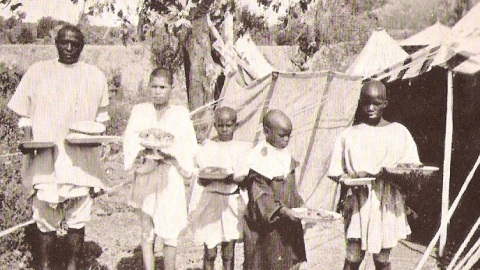Spanish Colonial Policy Toward Slavery in Morocco (1880-1930)

During the last third of the nineteenth century the last Spanish colonies in America were witnessing the formal abolition of slavery, while Spain was exploring the possibilities for a colonial expansion in North Africa, where slavery was still an institutionalized practice, despite international bans and some dissenting voices within Muslim society itself.
The attitude of the Spanish authorities regarding the issue of slavery still remains a relatively unknown topic in Africanist literature. The Spanish colonial penetration also generated knowledge about the black populations of North Africa and especially those in situations of slavery and servitude. Racialism was the predominant approach from which Europeans classified those populations, under a scientific legitimacy that presented them as an inferior form of humanity despite the anti-abolitionist debates of the time.
|
|
| Figure 1. Source: R. Forbes. 1924. Raisoeni. De Sultan van de Bergen, Amsterdam, Em. Querido, p. 247. |
Mostremarkable about this is that despite the existence of international law prohibiting slavery, this practice remained implicit for almost the entire colonial period, although the sale of slaves was banned in the early 1920s. Spanish colonial authorities, however, remained ambivalent towards the slaves as they chose not to ban the practice of servility and simply accepted the facts. The explanation for this policy of non-interference may be found in pragmatic reasons: the Moroccan elites who maintained clientelistic relationships with the colonial authorities to maintain the colonial administrative system, lodged in their houses dozens of men and women of slave origin, especially in the city of Tétouan, but also in other cities and rural areas.
The article presents two unpublished reports made by reknowned maroquinistes, such as the Franciscan Fray José Lerchundi in 1889, and the Arabist officer and interpreter Clemente Cerdeira in 1923. While Lerchundi’s report was done before the Protectorate and he tried to eradicate the sale of slaves and to promote evangelization among them, Cerdeira’s report is a principles declaration of the Spanish official policy: to respect slavery, since its nature was not based on an open exploitation, so that “the abolition of the system of slavery in Morocco, we believe that it would be inappropriate and certainly cause enough reason to generate serious disorders in the country (...).” The fact is that most of the Moroccan notables of the Protectorate’s capital had maids purchased in markets or through particular transfers, and the colonial authorities chose to leave out the issue, refusing even to respond to the demands of information from the League of Nations since 1921.
This research is part of a more ambitious project that aims to show the historical roots of current debates about the existence of racism in Morocco, and particularly the institutional violence practiced both by Spain and Morocco on the Africans caught at the borders of Ceuta and Melilla.
Department of Social and Cultural Anthropology
References
Mateo Dieste, Josep Lluís. Imágenes y ambivalencias de la política española hacia la esclavitud en Marruecos (1880-1930). Historia y Política. 2014, vol. 31, p. 255-280.


